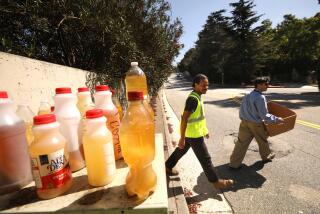Maybe a Treasure-Trove . . . or a Cadaver : In the Sewer It Can Be Finders Keepers
- Share via
Guns, knives, folding money, loads of concrete, pieces of safes, gardeners’ cuttings, advertising circulars, bottles, purses, credit cards, dead dogs (occasionally a live one), rats, cockroaches--all wind up in storm drains.
“It is an excellent place to hide (something). This year alone, we found an M-1 (rifle), a shotgun, a revolver,” said Ardis Cash, an employee of the company that holds the $79,054 contract for this year’s cleanup of the South Bay’s 5,000 storm drains.
The crews, working just beneath the curb, sometimes come across more unusual stuff: a diamond ring, furniture . . . even people.
“In the San Pedro area, people sleep in them,” said Cash. In Thousand Oaks, he said, one unfortunate went to the Big Sleep there: The man’s murderers used a storm drain to hide his inconvenient corpse.
Although catch basins range from three feet deep and six feet long to cavernous vaults stretching across several properties, sometimes what is in them appears to be too big to fit down the manhole or through the street drain. In Pico Rivera, a surprised cleanup crew found a kitchen table and two chairs in a storm drain.
“I don’t know how they got it down there,” Cash said, adding that he thought people might have been using the large drain for underground card games.
In Carson, for no known reason, Cash confided in a lowered voice, his crews found a sizable number of the most improbable objects--what skin magazines delicately advertise as “marital aids.” He shook his head in wonderment.
Similarly, other areas of the South Bay, viewed below street level, have their own stamp, according to Cash.
In Inglewood, Hawthorne, Lennox and Torrance, the pickings frequently include weapons, drugs and purses. He finds sand, naturally enough, in storm drains in the beach cities, but also lots of credit cards. In Lomita and on the Palos Verdes Peninsula, construction trash and surplus cement frequently appear in the drains.
Nothing more unusual than Budweiser cans and moldy leaves turned up during a recent foray under Lomita streets with Cash and one of his crews.
Not even excess concrete.
Cash had worried about that as he approached the intersection of 259th Place and Avocado Street and spotted town-home construction. Some contractors, he said, just dump their surplus concrete down storm drains, risking a $500 fine. It can take a jackhammer, which Cash as contractor has to pay for, to chip it out.
On the Job at 5:30
The men, who are on the job at 5:30 a.m., earn $6.25 an hour--after a 30-day break-in period at $5 an hour. Each three-man crew cleans out 50 to 60 storm drains a day.
While children played nearby, crew leader Leon Jones, 35, who is training to be a minister, deftly unbolted a manhole cover using a customized wrench, levered it up and then checked for poison gas with a hand-held gadget.
George Gudino, 18, of Inglewood, maneuvered his lower body into the manhole, crouched into the three-foot depth and began clearing out the debris with a sawed-off shovel. The trash quickly went into heavy-duty plastic sacks and then into a rented van. Cash’s nephew Troy, sporting a bandanna on his head, was busy meanwhile across the street in another storm drain.
Cash, who works for Executive Suite Services Inc. of Northridge, said he prefers to have the storm drains cleaned manually--rather than by a truck with a giant vacuum attachment--because it is cheaper and provides work to more people. “We hire from the unemployed lines and you move faster with human beings as opposed to equipment,” he said.
He said he uses the vacuum truck only when something possibly infectious like a dead dog is encountered.
Not Always Uneventful
For Cash’s crew members, the work is not always uneventful.
“We have difficulty with kids falling into them,” Cash said as he waved away the neighborhood children who were coming up to watch. “One kid rode his bike into one.”
Elsewhere the danger is to crew members.
“In the inner city, people have come and attacked them,” Cash said. “That’s why I insist they work in threes.”
But in one high-crime area, the cleanup apparently cooled off crime.
Several years ago, Cash said, he hired several dozen men from an area known for robberies. One day while he was out with the crews, a police officer came by.
“We really appreciate what you are doing,” Cash recalls the officer telling him, “because the robbery rate really dropped down.” Cash said he had apparently hired some of the robbers.
Some Are Tempted
If working on the drains can keep some out of trouble, Cash said, it can be a temptation for others, particularly when they see credit cards.
“I had to get two (crew members) out of jail. They had a pocket full of credit cards,” he said.
Cash said he used to call the police when his crews found weapons, purses, credit cards or something possibly connected with a crime. The police told him it was his property and not to bother calling them, he said.
Sgt. Donald Neureither of the sheriff’s Lennox station said no detectives could recall solving a crime with evidence found in a storm drain. But he added that he hoped that the cleanup crews would contact the office when they find guns.
Cash concedes that his crews generally keep what they find--stashing away aluminum cans in sacks, often finding money overlooked by a purse-snatcher--despite lectures to turn it in.
“I have to constantly remind the guys not to put these things in their pockets,” he said, “(but) . . . I find if you try to regulate them, you don’t get the work done.”
More to Read
Sign up for Essential California
The most important California stories and recommendations in your inbox every morning.
You may occasionally receive promotional content from the Los Angeles Times.













